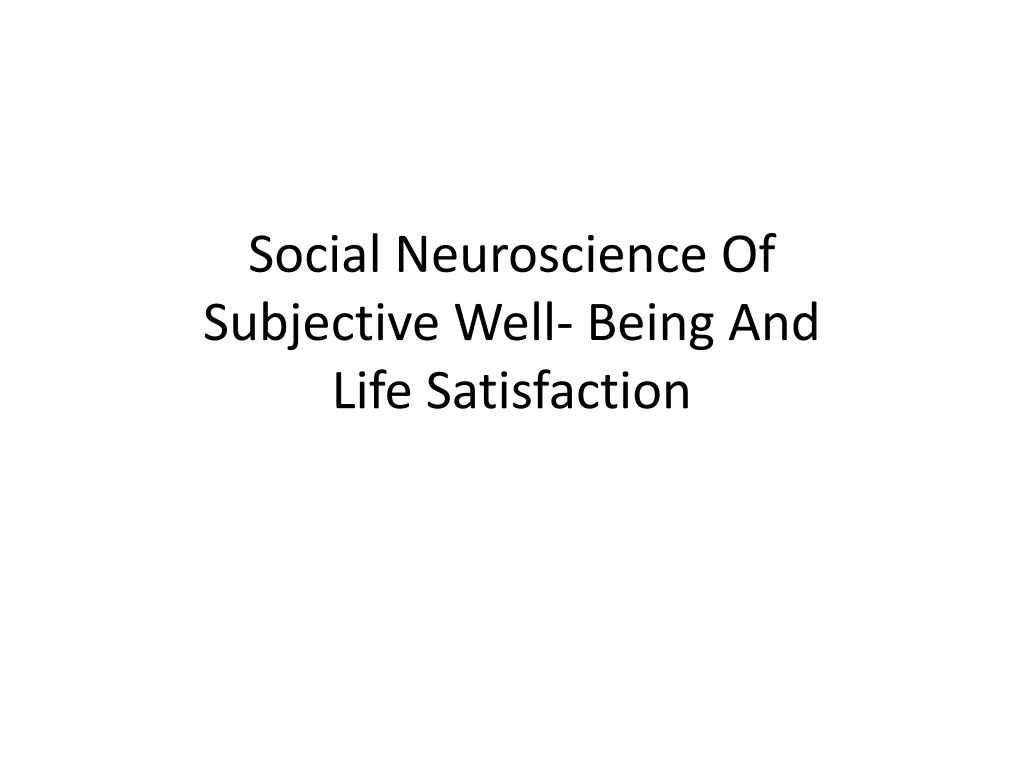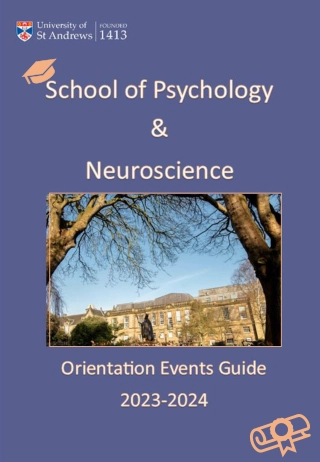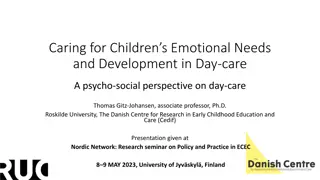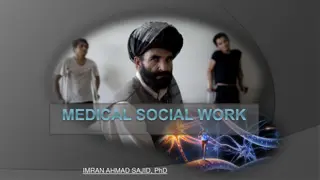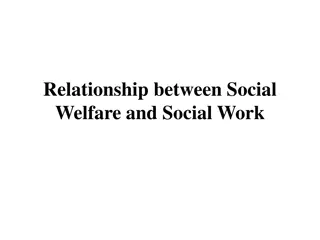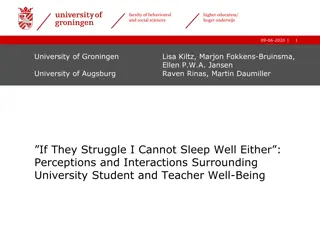Understanding Social Neuroscience: Exploring Human Sociality and Well-Being
Social neuroscience delves into how the brain processes social interactions and their impact on human well-being. It focuses on the interconnectedness between social connections and overall life satisfaction, suggesting that humans are inherently social beings with a strong need for social belonging. Research in this field often examines the role of the neocortex in complex cognitive functions related to social cognition, emotion regulation, and sensory perception. Evolutionary theory supports the idea that brain connectivity, particularly within the prefrontal cortex, is crucial for human social behavior. Ultimately, our social brain allows us to navigate the intricate social world, fostering positive and meaningful interactions.
Download Presentation

Please find below an Image/Link to download the presentation.
The content on the website is provided AS IS for your information and personal use only. It may not be sold, licensed, or shared on other websites without obtaining consent from the author. Download presentation by click this link. If you encounter any issues during the download, it is possible that the publisher has removed the file from their server.
E N D
Presentation Transcript
Social Neuroscience Of Subjective Well- Being And Life Satisfaction
Evidences Social neuroscience seeks to explain how the brain computes and facilitates social interactions and processes. A key assumption of this field is that humans are fundamentally a social species; as such, sociality and well- being are closely linked. Humans have a fundamental need to belong such that social connections are as important to survival as food and water.
Evidences Accordingly, much of the research in social neuroscience has examined how people think about themselves and others in social contexts as well as how such thoughts influence well- being. Supporting human social nature is the neocortex the outermost and most evolutionarily recent layer of our brain. Broadly speaking, the neocortex is crucial to a wide variety of complex cognitive functions, including language, conscious thought, social cognition, emotion regulation, and sensory perception.
Evidences Evolutionary theory proposes that pair bonding, a strong affinity between partners of a species potentially leading to offspring or lifelong bonding, and paternal nurturing drove the development of this higher- order, specialized brain tissue. Researchers have proposed that the mechanisms supporting pair bonding also generalize and extend to the formation of larger social groups.
Evidences Specifically, neocortex volume increases in a linear fashion with social group size in primates. However, what truly sets humans apart from other primates is not brain size but rather brain connectivity; specifically, the complex and intricate (karma k) connections of a specialized part of neocortex, the prefrontal cortex.
Evidences Humans are endowed (verilmek) with a brain that facilitates social interaction, in other words, a social brain . This social brain allows us to navigate the complex communal world in which we live and to obtain positive, meaningful social interaction and acceptance.
The Methods of Social Neuroscience EEG measures electrical activity in the brain and is most often used because of its excellent temporal resolution. EEG has provided insights into how different activation patterns and frequency bands relate to internalized attention, positivity, and well- being. Unfortunately, EEG has poor spatial resolution and therefore is less useful for understanding localization of brain function.
The Methods of Social Neuroscience To assess localization of brain function, most research has used fMRI, which measures brain activity by detecting changes associated with blood flow. When a neural region activates in response to a stimulus, blood flow to the region increases as nutrients and oxygen are delivered. Essentially, fMRI is able to identify brain regions whose activity is correlated with mental states or behavior.
Identifying the Networks The default network plays an especially prominent role in well- being. The default network is maximally active at rest. That is, when a person is lying in the scanner without an external task, activity within this network is very high. Several theorists believe that the default network is involved in various aspects of self- reflection.
Identifying the Networks Whenever a person is asked to perform a task, irrespective of task type, the default networks shows a reduction in activity. Dysfunction within this network is associated with a wide range of psychological disorders including: depressive disorders, anxiety disorders, other types of psychopathology such as schizophrenia and bipolar disorder and autism spectrum disorders, abnormalities in aging.
The Social Brain and Well- Being Well- being requires a functioning social brain. But, what does the brain need to do to allow it to be social? Given the fundamental need to belong, a social brain system needs to monitor signs of social inclusion or exclusion and alter behavior to forestall ( n ne ge mek) rejection or resolve other social problems.
The Social Brain and Well- Being Such a system requires four components, each of which is likely to have a discrete neural signature. First, people need self- knowledge to be aware of their behavior so as to gauge ( l mek) it against societal or group norms. Thus, having a self serves an adaptive function for group living.
The Social Brain and Well- Being Second, people need to understand how others are reacting to their behavior so as to predict how others will respond to them. In other words they need theory of mind, the capacity to attribute mental states to others. This implies the need for a third mechanism, one that detects threat, especially in complex situations.
The Social Brain and Well- Being Finally, there needs to be a self- regulatory mechanism for resolving discrepancies between self- knowledge and social expectations or norms, thereby motivating behavior to resolve any conflict that exists.
Neuroscience of Threat Detection and Social Belonging Given the importance of creating and maintaining relationships for well- being, people ought to possess some sort of neural mechanism to monitor their status within their group. The anterior cingulate cortex (ACC), traditionally associated with detecting threats of social exclusion, is one such region.
Neuroscience of Threat Detection and Social Belonging Failure to form social relationships with others threatens health and well- being and leads to feelings of loneliness. Loneliness refers to feeling distressed about the quantity or, more perhaps more importantly, the quality of one s social. Loneliness is associated with a host of psychological difficulties, cognitive deficiencies, sleeping problems, abnormal physiological function, irregularities in the neuroendocrine system, and improper immune functioning.
Neuroscience of Threat Detection and Social Belonging A defining mark of loneliness is deriving little pleasure from social interactions. By contrast, in most instances, those who are not lonely find social interaction rewarding. Some of the first work examining the neural mechanisms associated with loneliness examined the reward system.
Neuroscience of Threat Detection and Social Belonging https://www.ted.com/talks/martin_seligman_ on_the_state_of_psychology/transcript?langu age=tr Happy place exercise
